Flags and symbols of Yorkshire have been used to identify Yorkshire and its related councils through flags and symbols (including coats of arms). This article also includes flags and symbols used by the present and former local authorities covering Yorkshire.
Yorkshire
| Emblem | Use | Description |
|---|---|---|
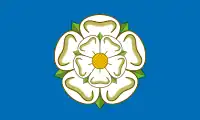 | Yorkshire | The flag used to represent Yorkshire is a White Rose of York on a blue background. The design dates from the 1960s.[1][2] The flag was registered by the Flag Institute on 29 July 2008 at the request of the Yorkshire Ridings Society.[2][3] The design registered by the YRS was one of three rival flag designs for Yorkshire.[4] |
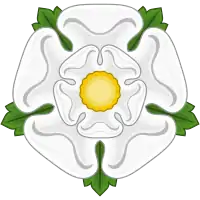 | Yorkshire | Almost all Yorkshire symbolism contains the White Rose of York, which originated as the symbol of the House of York. It was later also used as a Jacobite symbol. |
The Ridings – three traditional geographic and culturally historic areas of Yorkshire
| Emblem | Use | Description |
|---|---|---|
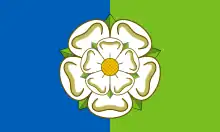 | Yorkshire, East Riding | The flag was registered by the Flag Institute on 18 April 2013 as the winning entry in a competition organised in conjunction with it.[5] The flag features a Yorkshire white rose, displayed in the East Riding style with one sepal at the top, set against a bi-colour of blue at the hoist, representing the sea and the historic maritime activities of the East Riding and green in the fly symbolising the locality's rich agricultural land. Additionally, the blue hoist colour signifies the East Riding's connection to the whole of Yorkshire whilst the green is placed towards the fly to represent its position in the east of the county.[6] The county town is Beverley. |
 | Yorkshire, North Riding | The flag was registered by the Flag Institute on 4 May 2013 as the winning entry in a competition organised in conjunction with it.[7] The yellow edged blue cross recalls the colours (yellow stars on a blue background) of the arms attributed to the local saint, Wilfrid a major figure in the early history of the region. Set against a green field, the three colours in combination allude to the North Riding's natural features; the green representing the large tracts of the famed North York Moors National Park, while the blue and yellow reflect the North Sea coastline (with its sandy beaches at Saltburn, Runswick Bay and Redcar Beach for example) and such rivers as the Swale, Tees and Esk.[8] The county town is Northallerton. |
 | Yorkshire, West Riding | The flag was registered by the Flag Institute on 23 May 2013 as the winning entry in a competition organised in conjunction with it. The flag features a "rose-en-soleil" device first used by Edward IV upon his accession to the throne, combining the White Rose of the House of York with the Sun emblem used by his royal predecessor, Richard II. In essence the rose-en-soleil is a more elaborate version of the white rose emblem associated with the county and had been used by the former West Riding council in its coat of arms. The rose emblem is placed against an offset red cross in Scandinavian style, reflecting the Anglo-Scandinavian history of the region during the era when the Ridings were first established. The cross may be seen therefore as a Nordic cross in English colours, a graphic encapsulation of local heritage and history. The county town is Wakefield. |
Councils
Administrative county councils prior to 1974
The administrative county councils prior to 1974 covered the traditional geographic historical Ridings of Yorkshire, subject to minor boundary changes of administrative areas in the 1960s along the River Tees area. In each case the councils were granted by letters patent issued by the officers at the College of Arms. The councils of the administrative counties were abolished in 1974 and the coats of arms became obsolete.
| Coat of arms | Use | Blazon and description |
|---|---|---|
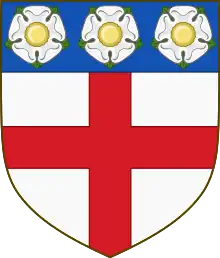 | North Riding County Council | Blazon:Argent a cross gules; on a chief azure three roses argent barbed and seeded proper.[9] Granted 1 March 1928, but used unofficially from 1889.[10] The arms combined St George's Cross with white Yorkshire roses.[11] |
 | West Riding County Council | Blazon:Ermine a rose argent, barbed and seeded proper and en soleil Or; on a chief gules three roses of the second barbed and seeded proper. The arms ensigned by a mural crown Or[9] Granted 2 February 1927. The "sun in splendour" behind the rose was also used as a symbol of the House of York in the times of Edward IV and Richard III.[12] The Latin motto adopted by the council was Audi Consilium meaning "heed counsel".[11] |
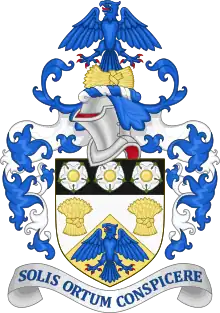 | East Riding County Council | Blazon:Per chevron argent and Or, in chief two garbs proper and in base an eagle displayed azure; on a chief sable three roses argent barbed and seeded proper.[9] Granted 28 February 1945. Before 1945 the county council used an unofficial coat of arms consisting of a gold shield bearing a blue eagle. This was taken from the seal of the borough of Beverley, the county town. The "garbs" or heraldic wheatsheaves represented agriculture. The grant also included a crest displayed on a helm above the crest: on a wreath of the colours, on a garb fessewise Or an eagle displayed azure.[11] The Latin motto (also not shown in the illustration here) was Solis Ortum Conspicere or "To behold the sunrise".[13] |
Metropolitan and non-metropolitan county councils 1974–1986 / 1974–1996
Following the reorganisation of the administrative county council areas by the Local Government Act 1972, the established three county councils were replaced on 1 April 1974 by four new county council areas: the metropolitan counties of South Yorkshire (centred on Barnsley), and West Yorkshire (centred on Wakefield), and the non-metropolitan counties of North Yorkshire (centred on Northallerton) together with the non-Yorkshire named Humberside (centred on Beverley). All four of the new 1974 county councils received grants of complete "achievements" of arms consisting of a shield, crest and supporters.
On 1 April 1986 the two metropolitan county councils in Yorkshire were abolished under the Local Government Act 1985. Administratively, the new county areas legally remained in existence and were from that date administered by the former lower tier metropolitan district councils (City of Wakefield, City of Leeds, City of Bradford, Calderdale (Halifax), Kirklees (Huddersfield), for West Yorkshire, and Barnsley, City of Sheffield, Rotherham and Doncaster, for South Yorkshire). On 1 April 1996 the non-metropolitan county of Humberside was also abolished, being replaced north of the River Humber by new administrative unitary councils, The East Riding of Yorkshire Council (which despite the name did not share the traditional geographic historic area of the former East Riding County Council) centred at Beverley, and Kingston-upon-Hull City Council.
| Coat of arms | Use | Blazon and description |
|---|---|---|
 | North Yorkshire County Council |
Blazon: Argent a bendlet wavy azure and a bendlet sinister wavy vert over all on a cross gules five roses argent barbed and seeded proper. Crest: On a wreath argent and azure upon a mural crown gules a lion passant guardant Or supporting with the dexter forepaw a rose argent barbed and seeded proper en soleil. Supporters: Upon a compartment of a heather moor proper on the dexter a lion Or holding in the sinister forepaw a sword argent hilt pomel and quillons gules and resting the sinister hindpaw on a fountain on the sinister a lion Or holding in the dexter forepaw two keys in saltire argent and resting the dexter hindpaw on a serpent coiled proper. Granted 29 April 1980 The cross of St George comes from the arms of both the North Riding County Council and the City of York which were combined in the new county. The cross bears five white roses. In the background of the shield are narrow green and blue waves representing the Yorkshire Dales and Wolds. The crest featured a lion from the York city arms supporting the "rose en soleil" from the arms of West Riding County Council. Two gold lions also support the arms. A number of symbols were added for heraldic difference: crossed keys for the archdiocese of York, the sword borne before the Lord Mayor of York, a serpent for St Hilda of Whitby and a heraldic fountain for the county's coats and waterways. The Latin motto is Unitate Fortior or "stronger by union".[14] |
 | West Yorkshire County Council | Blazon: Or two piles azure a rose argent barbed and seeded proper. Crest: on a wreath of the colours a mural crown Or standing thereon a lion rampant guardant per fess gules and tenné crowned Or bearing in its forepaws a rose argent barbed and seeded proper. Supporters: Dexter a lion rampant guardant per fess gules and sable armed and langued azure crowned and charged on the shoulder with a sun in splendour Or sinister a lion rampant guardant per fess tenné and vert armed and langued gules crowned Or charged on the shoulder with a rose argent barbed and seeded proper, the whole upon a compartment representing the Pennine Hills. Granted 22 August 1975 The arms featured a "W" shaped pattern and white rose to represent "West Yorkshire". The crest and supporters were crowned lions. They were each of two colours: red and black (gules and sable) were for industry; green and earth colour (vert and tenné) were for agriculture. The motto was "By effort achieve".[15] With the abolition of the county council in 1986 these arms became obsolete. |
 | South Yorkshire County Council | Blazon: Sable a pile throughout barry dancetty argent and gules over all a pile reversed throughout counterchanged in the sable a rose argent barbed and seeded proper between two like roses dimidiated and issuing from the flanks. Crest: Issuant from a mural crown gules a rose argent barbed and seeded proper dimidiating a bezant. Supporter: Dexter a horse guardant Or crined and unguled sable supporting with the dexter forehoof a hoe gules sinister a lion guardant sable maned Or supporting a miner's pick-axe gules. Granted 1978. The black diamonds represented coal mining and the red and silver zig-zag pattern steel processing: on top of these were placed white roses. The crest was a Yorkshire rose joined to a "bezant" or golden coin for the county's wealth. The supporters: a horse with a hoe and a lion with a pick-axe stood for agriculture and coalmining respectively. The motto was "Each shall strive for the welfare of all".[16] With the abolition of the county council in 1986 these arms became obsolete. |
Non-metropolitan district council (unitary authority) from 1996
| Coat of arms | Use | Blazon and description |
|---|---|---|
 | East Riding of Yorkshire Council | Blazon: Barry vert and Or on a chevron engrailed plain cotised gules three roses argent barbed and seeded proper. crest: issuing from a mural crown argent an eagle displayed gules armed and langued azure supporting with the dexter talons a sword hilt upwards and with the sinister talons a crozier in saltire Or; mantled gules doubled argent. Supporters: on the dexter a lion azure guardant armed and langued gules gorged with a wreath of barley supporting between the forelegs a trident Or; on the sinister a demi-horse argent langued gules maned Or the feet webbed vert conjoined to the lower half of a Hippocampus vert supporting between the forelegs set upon a staff a cross fleury gules.
Granted 1996. The green and gold stripes of the shield represent the wealth generated by the land of the East Riding. On top of this is placed a distinctive chevron bearing Yorkshire roses. The engrailed edge and cotises were added to ensure that this simple coat of arms was unique. The crest features the eagle used by the former East Riding County Council, now coloured red. The history and industry of the area are represented by a crozier and a sword. The decorative mantling hanging from the helm is in red and white, the colours of St George. The dexter supporter is a blue lion. This featured in the insignia of the predecessor Beverley and Boothferry Borough Councils. About the lion's neck is a wreath of barley. The sinister supporter is a seahorse, for the maritime interests of the county. The motto chosen by the council is "Tradition and progress".[17] |
British Army
| Symbol | Use | Description |
|---|---|---|
 | Yorkshire Regiment | Tactical Recognition Flash of the Yorkshire Regiment of the British Army |
See also
- Flying Colours Flagmakers company based in North Yorkshire
References
- ↑ "Yorkshire (United Kingdom)". CRWFlags.com. Retrieved 24 October 2007.
- 1 2 "Yorkshire". Flag Registry. Flag Institute. 5 July 2008. Retrieved 3 August 2008.
- ↑ Martin Wainwright (29 July 2008). "Proud Yorkshire can finally fly white rose flag without charge". The Guardian. Retrieved 29 July 2008.
- ↑ Michael Faul (5 July 2008). "Which is your favourite flag for Yorkshire?". Halifax Courier. Retrieved 3 August 2008.
- ↑ "Yorkshire – East Riding". Flag Registry. Flag Institute. Retrieved 10 April 2013.
- ↑ "Yorkshire – East Riding Flag". British County Flags. 22 April 2013. Retrieved 20 May 2013.
- ↑ "Yorkshire – North Riding". Flag Registry. Flag Institute. Retrieved 10 April 2013.
- ↑ "Yorkshire – North Riding Flag". British County Flags. 5 May 2013. Retrieved 20 May 2013.
- 1 2 3 Geoffrey Briggs, Civic and Corporate Heraldry, London, 1971
- ↑ A C Fox-Davies, The Book of Public Arms, 2nd edition, London, 1915
- 1 2 3 C Wilfrid Scott-Giles, Civic Heraldry of England and Wales, 2nd edition, London, 1953
- ↑ "The Edward IV Roll". Free Library of Philadelphia Rare Book Department. 24 October 2007. Archived from the original on 4 July 2007. Retrieved 12 January 2008.
- ↑ L G Pine, A Dictionary of Mottoes, London, 1983
- ↑ "North Yorkshire County Council". Civic Heraldry of England and Wales. Retrieved 18 June 2008.
- ↑ "West Yorkshire County Council". Civic Heraldry of England and Wales. Retrieved 18 June 2008.
- ↑ "South Yorkshire County Council". Civic Heraldry of England and Wales. Retrieved 18 June 2008.
- ↑ The Coat of Arms of East Riding of Yorkshire Council, leaflet published by the council.